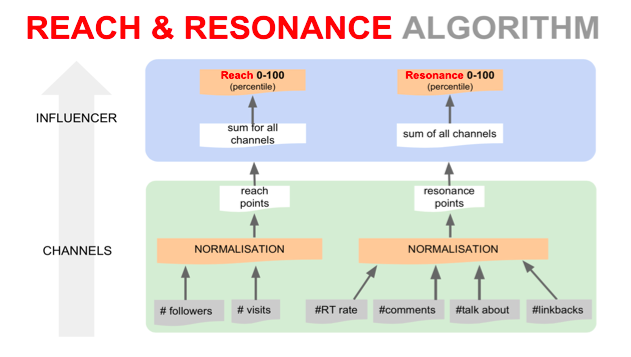Measuring wine writers influence through social media
by cescriva
2015-02-13
The Traackr social media influence platform that we used for creating the wine writers and bloggers index elicited a fantastic range of comments, appropriately via social media on Twitter and Facebook.
Measuring writers personally based on their social media engagement across all platforms through which they engage their audience is a fresh way of looking at the world, which is precisely what makes it interesting.
So let’s dig a little deeper into how writer-centric, social media online measurement actually works:
As previously explained, Traackr’s algorithm is based on 3 parameters: Relevance, Reach and Resonance.
In the case of the wine writer and bloggers index, Relevance – the measure of expertise within the subject –scored highly across the board, as one might expect and the keywords used to determine this were necessarily quite broad.
The distribution of scores that reflect relevance were in fact tighter than Reach or Resonance, so this proved rather less of a discriminating factor than it otherwise might have done.
Subscription sites that put most content behind a firewall can’t be measured of course, since web crawlers and searchers cannot access them, so some of the most influential wine writers in the world end up with low overall scores.
Although their Twitter and social media accounts may well score well, blog posts and articles posted across online properties (which can be measured as long as sufficient article or blog text copy is available via RSS feeds) are heavily weighted by Traackr, so these influencers don’t show up as being key influencers through social media as they don't disseminate their content through it.
They may have significant influence over wine trade and consumer buying decisions, and consequently wine prices and the market, due to their experienced palates and authoritative wine evaluation and writing skills, but this is not what’s being measured when ranking by social media influence.
Reach measures the size of audience, based on numbers of followers and visits across all reach points. This measure focuses on the writer as an individual, and their free-to-air content whichever online properties they write for (as long as they can be personally identified).
That brings us to Resonance. This describes how much endorsement and engagement is being generated by a piece of content; every comment against blog entries or articles that are accessible free-to-air and available via RSS feeds, every talk about, tweet and retweet.
Those wine writers who outperformed their peers in the resulting list engaged powerfully with their audience, generated disproportionately high numbers of comments and talk abouts, along with tweets and retweets.
There’s something special to a consumer about having a dialogue with people who are expert in their subject area, or otherwise connecting with them online, and it’s to be celebrated. Of course it’s a different measure of influence when compared to the dissemination of paid for, advisory content through traditional media (whether online or not). Today, however, we proudly recognise the wine writing stars of social media and the social web across its many forms and the significant contribution they make, passing on their knowledge, guidance and passion to the many millions of people interested in wine.

Posted in:
Infographics,
Tags:
fine wine, social media influence, Traackr, UK wine influencers, UK wine writers and bloggers, Wine, wine influencer, wine writers, wine writing,

